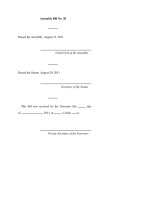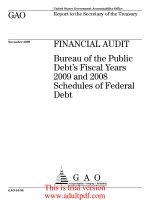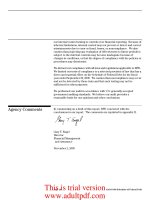Assembly Bill No. 38 Private Secretary of the Governor potx
Bạn đang xem bản rút gọn của tài liệu. Xem và tải ngay bản đầy đủ của tài liệu tại đây (78.19 KB, 8 trang )
Assembly Bill No. 38
Passed the Assembly August 31, 2011
Chief Clerk of the Assembly
Passed the Senate August 29, 2011
Secretary of the Senate
This bill was received by the Governor this day
of , 2011, at o’clock m.
Private Secretary of the Governor
CHAPTER
An act to add Division 18 (commencing with Section 40001)
to the Financial Code, relating to banking development districts.
legislative counsel
’
s digest
AB 38, Bradford. Banking: underserved communities.
Existing law provides for various programs and activities in the
development of economic opportunities for businesses in the state.
The California Small Business Financial Development Corporation
Law establishes small business financial development corporations
and provides for their regulation by the Business, Transportation
and Housing Agency. Existing law, the Banking Law, provides
for the regulation of banks by the Department of Financial
Institutions.
This bill would require the department to work with local
agencies to compile a list of underserved communities. The bill
would require the department to post that list on the department’s
Internet Web site.
The people of the State of California do enact as follows:
SECTION 1. The Legislature finds and declares all of the
following:
(a) Too many Californians are disconnected from the financial
mainstream. National estimates show that 10 percent of households,
including nearly one-quarter of the minority population, are
“unbanked,” meaning they lack a basic checking or savings
account. In California, 12 percent of adults do not have a checking
or savings account, according to the United States Census. Recent
market research indicates that Fresno and Los Angeles have the
second and third highest percentages of unbanked residents in the
country. In San Francisco, the Brookings Institution found that
one in five adults, and half the city’s African Americans and
Latinos, do not have bank accounts. The unbanked are most likely
to be people who are less educated and have lower incomes.
(b) The unbanked poor pay more to conduct their financial lives.
Utilizing check cashing outlets and money order services to pay
95
— 2 —
AB 38
bills and expenses can have costly side effects as the result of fees
and service charges.
(c) Families without accounts often do not have a safe place to
keep their money. They may walk around with large amounts of
cash in their pockets, or keep it at home in a coffee can. Robberies
can be more prevalent around check cashing outlets. A burglary
or fire could cost them their life’s savings in a matter of moments.
(d) Lower income households often pay more for financial
services. According to a recent Brookings Institution study, a
full-time worker without a checking account could potentially save
as much as $40,000 during his or her career by relying on a lower
cost checking account instead of check cashing services. As a
result, without a checking account or lower cost checking account,
lower income families have added difficulty saving for and
investing in wealth-building assets, the investments they do make
are too often not in their best financial interest, and business
opportunities in lower income markets are unduly depressed.
(e) A bank account is also the first step to financial security and
asset building for many families. A bank account helps people
take the first step onto this path. Without an account, it is much
more difficult to get well-priced car loans, credit cards, or
mortgages, which are the exact financial tools needed to climb up
the economic ladder. Many families stay stuck on a different and
more expensive path, going to pawn shops, payday lenders, and
rent-to-own stores.
(f) While financial institutions may see the long-term business
potential of underserved areas, they may have a short-term concern
that it would take a number of years before they can attract enough
retail deposits to become viable. Those concerns are magnified by
the fact that lower income workers often need to use banking
services in off-business hours because they work in multiple jobs,
making it more difficult for banks to attract customers with
standard business practices.
(g) In 1999, the State of New York established a Banking
Development District Program and made available a range of state
and city incentives to participating financial institutions. The
incentives provided through the program aim to help banks get
over short-term obstacles to profitability, enabling them to branch
into neighborhoods with long-term business potential, and better
serve low-income consumers with existing bank branches.
95
AB 38
— 3 —
SEC. 2. Division 18 (commencing with Section 40000) is added
to the Financial Code, to read:
DIVISION 18. BANKING IN UNDERSERVED
COMMUNITIES
40001. For purposes of this division, the following definitions
shall apply:
(a) “Bank” refers to any commercial bank, savings bank, savings
association, or credit union.
(b) “Underserved community” is a remote location or
impoverished area that lacks banking services commensurate with
the services provided to higher income areas with a population of
similar size.
(c) “Local agency” means a city, county, whether general law
or chartered, city and county, or town.
(d) “Department” means the Department of Financial
Institutions.
40002. (a) The department shall work with local agencies to
compile a list of underserved communities or regions that lack a
concentration of banks and services in order to provide banks with
a clear demonstration of those areas that are in the most need.
(b) The department shall post the list compiled pursuant to
subdivision (a) on the department’s Internet Web site.
95
— 4 —
AB 38
Approved , 2011
Governor









